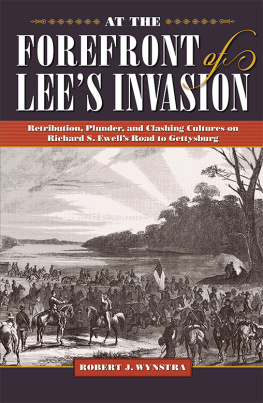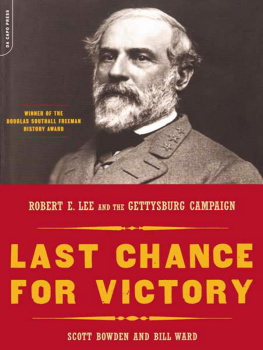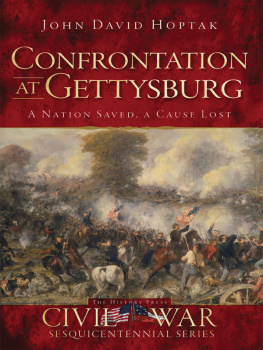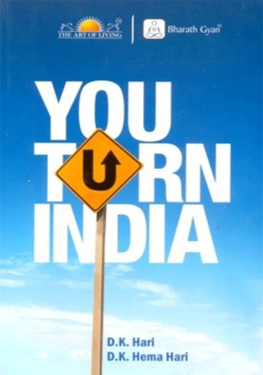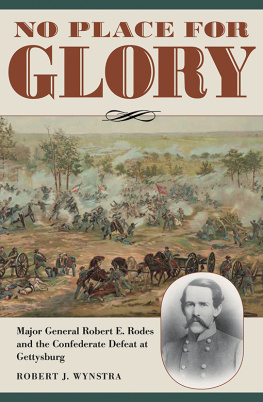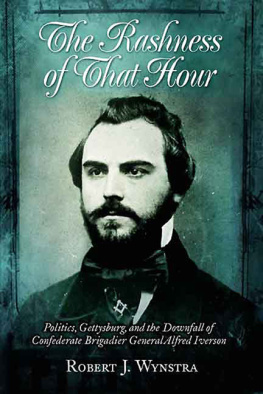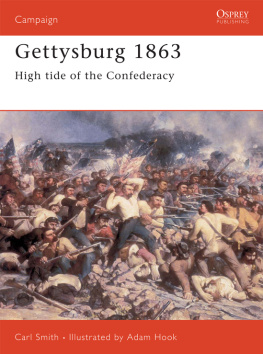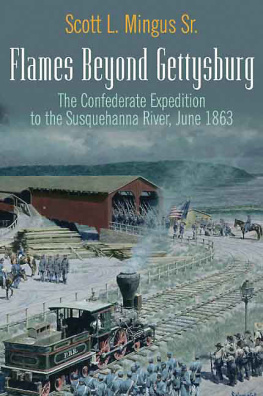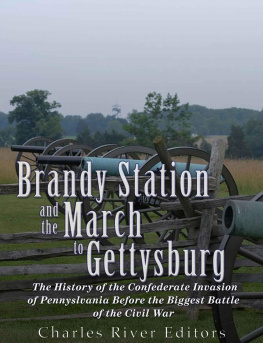At the Forefront of Lees Invasion
CIVIL WAR SOLDIERS AND STRATEGIES
Brian S. Wills, Series Editor
Richmond Must Fall: The Richmond-Petersburg Campaign, October 1864
HAMPTON NEWSOME
Work for Giants: The Campaign and Battle of Tupelo/Harrisburg,
Mississippi, JuneJuly 1864
THOMAS E. PARSON
My Greatest Quarrel with Fortune:
Major General Lew Wallace in the West, 18611862
CHARLES G. BEEMER
Phantoms of the South Fork: Captain McNeill and His Rangers
STEVE FRENCH
At the Forefront of Lees Invasion: Retribution, Plunder, and Clashing Cultures
on Richard S. Ewells Road to Gettysburg
ROBERT J. WYNSTRA
At the Forefront of
Lees Invasion
Retribution, Plunder, and
Clashing Cultures on Richard S. Ewells
Road to Gettysburg
Robert J. Wynstra
THE KENT STATE UNIVERSITY PRESS
KENT, OHIO
2018 by The Kent State University Press, Kent, Ohio 44242
All rights reserved
Library of Congress Catalog Number 2018008734
ISBN 978-1-60635-354-7
Manufactured in the United States of America
No part of this book may be used or reproduced, in any manner whatsoever, without written permission from the Publisher, except in the case of short quotations in critical reviews or articles.
LIBRARY OF CONGRESS CATALOGING-IN-PUBLICATION DATA
Names: Wynstra, Robert J., author.
Title: At the forefront of Lees invasion : retribution, plunder, and clashing cultures on Richard S. Ewells road to Gettysburg / Robert J. Wynstra.
Description: Kent, Ohio : The Kent State University Press, [2018] | Series: Civil War soldiers and strategies | Includes bibliographical references and index.
Identifiers: LCCN 2018008734 | ISBN 9781606353547 (hardcover ; alk. paper)
Subjects: LCSH: Gettysburg Campaign, 1863. | United States--History--Civil War, 1861-1865--Campaigns. | Ewell, Richard Stoddert, 1817-1872.
Classification: LCC E475.51 .W96 2018 | DDC 973.7/349--dc23
LC record available at https://lccn.loc.gov/2018008734
22 21 20 19 18 5 4 3 2 1
Contents
This book would not have been possible without kind assistance from numerous people, who shared my enthusiasm for the project. I would especially like to acknowledge prolific author and researcher Scott Mingus Sr., who was kind enough to review my manuscript and contribute from his treasure trove of knowledge about Maj. Gen. Jubal Earlys activities in York County, Pennsylvania. His earlier classic book on the Confederate advance to York and Wrightsville, Pennsylvania, served as one of the primary inspirations for my interest in this topic. Without his help and encouragement, my task would have been much more difficult.
Author Steve French generously reviewed many versions of the manuscript and contributed several valuable documents. He has long been a kind friend and source of vital information on wartime activities in the Shenandoah Valley. Most important, I thank him for putting me in touch with Kent State University Press, which ultimately made this book possible.
The young prodigy Cooper Wingert repeatedly provided me with some elusive documents that I could not have obtained or even known about without his kind help. Author Gregory White also went the extra distance to supply me with several newspaper accounts and other important documents from his home state of Georgia. Seasonal ranger and author Charles Teague graciously helped me obtain several important items from the Gettysburg Military Park Library. He also joined me in walking the field at Gettysburg and provided invaluable insights on the terrain and its influence on the battle. Most of all, his enthusiasm and support for my projects over the years are greatly appreciated.
Credit is also due to Thomas L. Elmore, who reviewed my manuscript and contributed several vital documents, diaries, and letters. Benjamin Hoover II provided me with an invaluable family letter for use in my research. Howard Land allowed me to quote from his relatives Civil War diary. The late John Chapla kindly gave me access to several important letters regarding the activities of the Forty-Second Virginia. Fred Ray as always willing shared from his vast storehouse of information on Maj. Eugene Blackford and the sharpshooters in Rodess Division.
My appreciation extends to prolific author Eric Wittenberg for his early interest in my various projects and his kind assistance over the years. J. David Petruzzi also deserves special recognition for his encouragement and help. Without exception, the staffs from the numerous public and private archives and other institutions that provided source material and photographs for this book were remarkably helpful. From large to small, they provided the kind of dedicated service that makes my research so enjoyable. Thanks are also due to Phil Laino for his superb maps, which so greatly enhance this publication.
Of course, this book would not have been possible without the support from acquisitions editor William Underwood and the staff at Kent State University Press, which well deserves its reputation as one of the premier Civil War publishers in the country. Their enthusiasm and unmatched professionalism made every step in the publishing process remarkably easy. Without them, this book would have been impossible. Thanks are also due to copyeditor Kevin Brock, who patiently guided me through the many baffling intricacies of the Chicago Manual of Style. Without his expert help, my efforts would have fallen well short of the mark.
Lastly, I would like to thank Anita Povich for her constant help. Every time I faltered she was there to pick me up and prod me to move forward. Many times she showed more faith in my ability to pull off this project than I did. Without her support and encouragement, I certainly would still be struggling to finish this book.
After clearing the Shenandoah Valley of Federal troops, Gen. Robert E. Lees bold invasion into the North reached the Maryland shore of the Potomac River on June 15, 1863. A week later the Confederate infantry crossed into lower Pennsylvania, where they had their first sustained interactions with the civilian population of a solidly pro-Union state, laying bare the enormous cultural gulf that separated the two sides in the war. Most of these initial encounters in the lush Cumberland Valley and adjacent regions of Pennsylvania involved the men from the Army of Northern Virginias famed Second Corps, leading the way as Lees veteran soldiers advanced north toward their eventual showdown with the Union Army of the Potomac at the crossroads town of Gettysburg.
Lt. Gen. Richard S. Ewell had assumed command of this newly reorganized corps on June 1 as the successor to Lt. Gen. Thomas J. Stonewall Jackson, who succumbed on May 10 to complications from the accidental wounds he suffered eight days earlier at Chancellorsville. Ewell, who had finally recovered from the loss of his left leg less than a year before, returned to the army on May 29, arriving in the Fredericksburg area early that day on a train from Richmond. At the age of forty-six, Ewell now ranked as third in command of the army, behind only Lee and Lt. Gen. James Longstreet. His corps included the three divisions commanded by Maj. Gens. Jubal A. Early, Edward Old Allegheny Johnson, and Robert E. Rodes.

